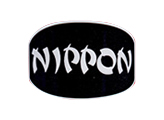Getting the best from Hydrangeas
Getting the best from Hydrangeas
Hydrangeas are such reliable flowering shrubs and they suit gardens of all sizes. They flower for much longer than most other plants, months rather than weeks in many cases. Often the blooms remain attractive even after they have faded, adding interest to the garden, even in winter. They also make excellent flowers for cutting.
The good news is that they are easy to grow, both in pots and in the open ground. All they need is the right situation, plenty of water in dry weather and occasional feeding with the right fertiliser; one that is formulated to bring out the best in them.
Planting hydrangeas
Pot grown hydrangeas can be planted at any time of year, in the open ground or in pots and containers using John Innes compost. Choose nice big pots that will allow the plants to grow happily for several years. Small containers dry out too quickly.
When planting in the open ground prepare the soil well, adding plenty of garden compost or organic manure to improve the soil structure. A few handfuls of 6X Natural Fibrous Fertiliser forked well into the soil is ideal to boost the humus content of the ground which helps with water and nutrient retention in future years.
Add a handful or Vitax Hydrangea Feed to the soil, or compost if growing in a pot, when planting. This provides all the essential nutrients for healthy growth and beautiful blooms.
Situation
Most hydrangeas will grow in an open sunny situation, but prefer light shade. They grow on most soils and thrive on heavy clay. This means they are ideal for most new-build gardens and wet, compacted soils. As the name suggests they like plenty of water, so adding organic compost or organic manure regularly helps to hold on to moisture. Mulching the ground around the plants with compost or bark early in the season when the soil is moist also helps to retain moisture. Do this after their annual application of Vitax Hydrangea Feed.
Keeping blue hydrangeas blue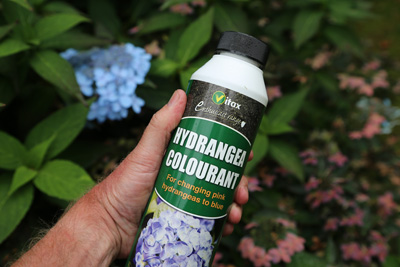
The mophead and lace cap hydrangeas, varieties of Hydrangea macrophylla, are the best known and offer the widest colour range. Their flowers often change colour during the season and the colour of some varieties is affected by the soil. Some are pink in alkaline conditions and blue on neutral to acid soil. To maintain the blue colour you can use Vitax Hydrangea Colourant, added to the soil when planting or to the growing medium in a pot. It can also be diluted in water and watered on to established plants. This should maintain the colour, but be patient. It does not always work instantly.
Other types of hydrangea 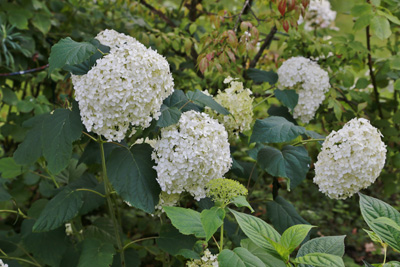
New varieties of hydrangea have been bred for compact growth and are ideal for small gardens. Many of these also flower on the new season’s shoots as well as those formed the previous year. Therefore they produce more flowers.
Other excellent garden hydrangeas include the popular Hydrangea arborescens ‘Annabelle’ which forms a clump of upright stems with soft leaves and large frothy, white flowerheads. It is good under the light shade of trees and produces a spectacular display when in bloom.
The varieties of Hydrangea paniculata are increasingly popular. These flower in late summer producing large, conical flower heads, reminiscent of lilac, at the tips of the shoots. Most are white, sometimes flushed with pink or burgundy. They are perfect for the back of a border with perennials.
Pruning hydrangeas 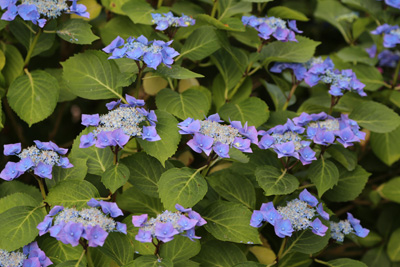
Pruning is easy.
Macrophylla hydrangeas: Leave the flower heads on the plants over winter, then cut back each stem to the first pair of fat buds behind the flower in spring. Some of the older stems can be cut back right to the ground in winter in the case of old, established plants.
Paniculata hydrangeas: Prune hard in late winter, cutting back by half to two-thirds. Retain a strong branch framework at the base of the plant. This produces vigorous shoots with flowers at the tips.
Arborescens hydrangeas: Cut back all stems to 15cm (6ins) in late winter. This may look drastic but it ensures strong shoots which should stay upright.
Feeding hydrangeas
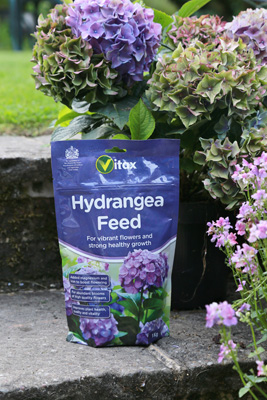
After pruning, or at any time in the growing season, feed by sprinkling Vitax Hydrangea Feed around the plants, work it into the soil surface with a fork or hoe and water thoroughly. Your hydrangeas will respond with fabulous flowers and foliage for one of longest lasting flower shows in the garden.
Andy McIndoe
For Vitax
Your login details have been used by another user or machine. Login details can only be used once at any one time so you have therefore automatically been logged out. Please contact your sites administrator if you believe this other user or machine has unauthorised access.







